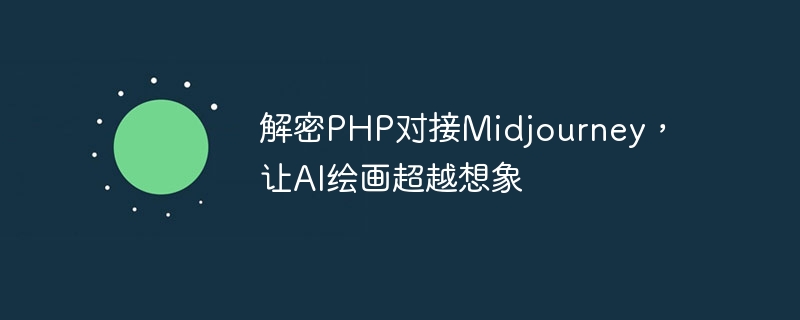

Decrypt PHP docking with Midjourney, making AI painting beyond imagination
In the process of continuous development, artificial intelligence (AI) has penetrated into various fields. The art of painting is no exception, and AI painting technology is receiving increasing attention and praise. Among the many AI painting platforms, Midjourney is a company that has attracted much attention. This article will introduce in detail how to use PHP to connect to Midjourney, making AI painting beyond imagination.
Midjourney, as a company focusing on AI painting, provides a rich API interface to easily integrate AI painting functions with your own website or application. As a widely used server-side scripting language, PHP has a wide range of applications and good scalability, making it an ideal choice for docking with Midjourney.
First, we need to register an account on the Midjourney official website and obtain the API key. After successfully registering and logging in, we can find our API key in the user backend. This key will be used for our API calls, so please keep it safe.
Next, we open a new PHP file and start docking Midjourney.
<?php
// 设置API密钥和请求URL
$api_key = 'YOUR_API_KEY'; // 替换成你的API密钥
$request_url = 'https://api.midjourney.com/artwork'; // 请求URL
// 要生成的图片URL
$image_url = 'https://example.com/image.jpg'; // 替换成你的图片URL
// 构建API请求数据
$request_data = array(
'api_key' => $api_key,
'image_url' => $image_url
);
// 发起API请求
$ch = curl_init($request_url);
curl_setopt($ch, CURLOPT_POST, true);
curl_setopt($ch, CURLOPT_POSTFIELDS, $request_data);
curl_setopt($ch, CURLOPT_RETURNTRANSFER, true);
$response = curl_exec($ch);
curl_close($ch);
// 处理API响应结果
$result = json_decode($response, true);
if ($result['status'] == 'success') {
// 调用成功,获取生成的图片URL
$generated_image_url = $result['generated_image_url'];
// 在网页中显示生成的图片
echo '<img src="' . $generated_image_url . '" alt="Generated Image">';
} else {
// 调用失败,输出错误信息
echo 'API error: ' . $result['message'];
}
?>In the above code example, first we set the API key and request URL as variables. We then create the API request data by building an array containing the API key and the image URL to generate. Next, we use the curl library to initiate a POST request and pass the API request data as POST parameters. Finally, we process the API response result, and if the call is successful, the generated image will be displayed.
It should be noted that in actual use, we need to replace YOUR_API_KEY and https://example.com/image.jpg in the code with our own API key and image URL.
Through the above code examples, we successfully connected to Midjourney's API and achieved the goal of applying the AI painting function to our PHP application. AI painting technology will bring our users a richer and more creative experience, far beyond our imagination.
In summary, the process of connecting PHP to Midjourney is relatively simple. You only need to obtain the API key, set the request parameters, initiate the API request and process the API response. In the middle, the curl library is used to initiate HTTP requests, and JSON format is used to process API request and response data. This docking method provides our application with powerful AI painting capabilities, making creations more interesting, unique, and beyond our imagination.
I hope this article will help you understand how to connect to Midjourney through PHP and realize AI painting beyond imagination. I wish you great success using Midjourney’s API!
The above is the detailed content of Decrypt PHP docking with Midjourney, making AI painting beyond imagination. For more information, please follow other related articles on the PHP Chinese website!




